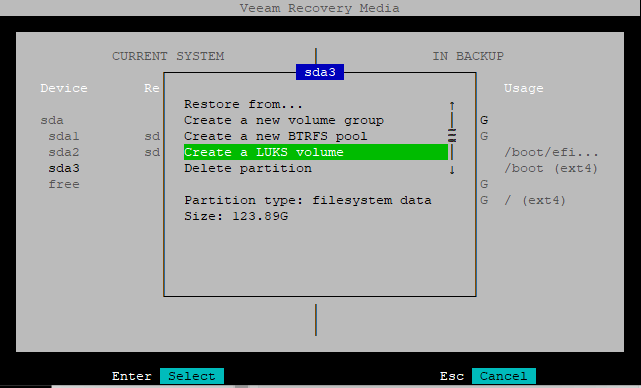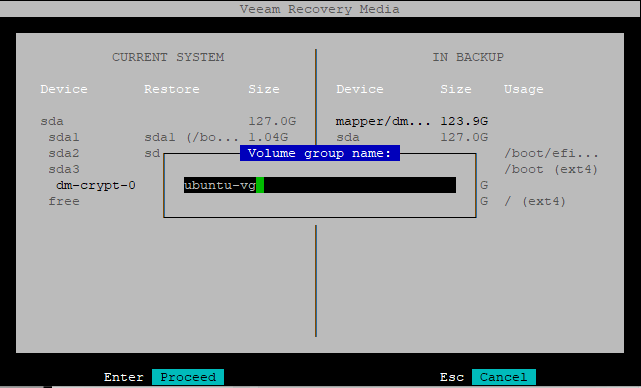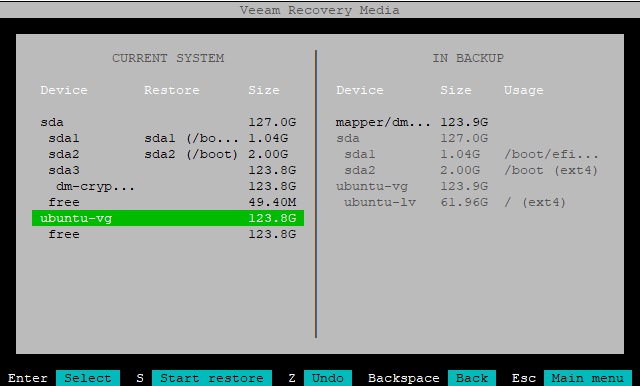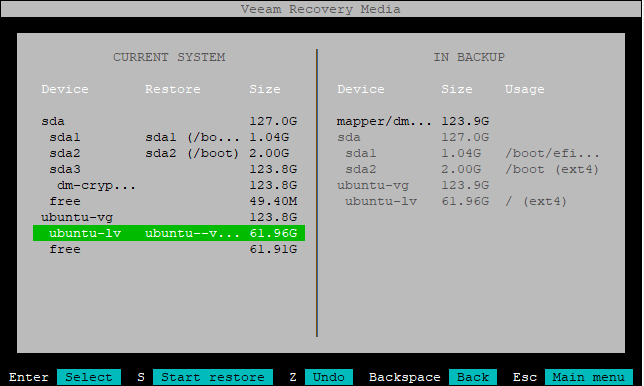Suppose I wanted to do everything through recovery UI as much as possible, except for setting the LUKS container ID, which simply cannot be done through recovery UI. Why does this not work very well?
When I start out fresh, it looks like this.
CURRENT SYSTEM │ IN BACKUP
│
Device Restore Size │ Device Size Usage
│
sda 127.0G │ mapper/dm... 123.9G
│ sda 127.0G
│ sda1 1.04G /boot/efi...
│ sda2 2.00G /boot (ext4)
│ ubuntu-vg 123.9G
│ ubuntu-lv 61.96G / (ext4)
│
Device Restore Size │ Device Size Usage
│
sda 127.0G │ mapper/dm... 123.9G
│ sda 127.0G
│ sda1 1.04G /boot/efi...
│ sda2 2.00G /boot (ext4)
│ ubuntu-vg 123.9G
│ ubuntu-lv 61.96G / (ext4)
I can then map sda to sda just as I did in the previous parts.
Device Restore Size │ Device Size Usage
│
sda 127.0G │ mapper/dm... 123.9G
sda1 sda1 (/bo... 1.04G │ sda 127.0G
sda2 sda2 (/boot) 2.00G │ sda1 1.04G /boot/efi...
free 123.9G │ sda2 2.00G /boot (ext4)
│ ubuntu-vg 123.9G
│ ubuntu-lv 61.96G / (ext4)
│
sda 127.0G │ mapper/dm... 123.9G
sda1 sda1 (/bo... 1.04G │ sda 127.0G
sda2 sda2 (/boot) 2.00G │ sda1 1.04G /boot/efi...
free 123.9G │ sda2 2.00G /boot (ext4)
│ ubuntu-vg 123.9G
│ ubuntu-lv 61.96G / (ext4)
And in the free space on sda, I can create a new partition (here: sda3).
Device Restore Size │ Device Size Usage
│
sda 127.0G │ mapper/dm... 123.9G
sda1 sda1 (/bo... 1.04G │ sda 127.0G
sda2 sda2 (/boot) 2.00G │ sda1 1.04G /boot/efi...
sda3 123.8G │ sda2 2.00G /boot (ext4)
free 49.40M │ ubuntu-vg 123.9G
│ ubuntu-lv 61.96G / (ext4)
Then I can create a LUKS container in sda3.
It will end up looking like this.
Device Restore Size │ Device Size Usage
│
sda 127.0G │ mapper/dm... 123.9G
sda1 sda1 (/bo... 1.04G │ sda 127.0G
sda2 sda2 (/boot) 2.00G │ sda1 1.04G /boot/efi...
sda3 123.8G │ sda2 2.00G /boot (ext4)
dm_crypt-0 123.8G │ ubuntu-vg 123.9G
free 49.40M │ ubuntu-lv 61.96G / (ext4)
Now I can try to map dm_crypt-0 with mapper/dm_crypt-0. But I am getting an error.
This would have mapped the LVM into the new LUKS container. I can try to map ubuntu-vg into dm_crypt-0. But this does not work either. Possibly because I chose to backup /dev/mapper/dm_crypt-0 as a device instead of /dev/mapper/ubuntu-vg--ubuntu-lv as an LVM.
It will look like this.
Device Restore Size │ Device Size Usage
│
sda 127.0G │ mapper/dm... 123.9G
sda1 sda1 (/bo... 1.04G │ sda 127.0G
sda2 sda2 (/boot) 2.00G │ sda1 1.04G /boot/efi...
sda3 123.8G │ sda2 2.00G /boot (ext4)
dm-cryp... 123.8G │ ubuntu-vg 123.9G
free 49.40M │ ubuntu-lv 61.96G / (ext4)
ubuntu-vg 123.8G │
free 123.8G │
Now I can start the restore, going from an empty disk to restoring everything in one go, all without leaving recovery UI. This looks too good to be true.
RECOVERY SUMMARY
1. Create GPT partition table on sda (scsi)
2. Create partition sda1 on sda (scsi)
3. Create partition sda2 on sda (scsi)
4. Create partition sda3 on sda (scsi)
5. Create CryptoLUKS: [dm_crypt-0] on device sda3 (scsi)
6. Restore sda1 (scsi) to sda1 (scsi)
7. Restore sda2 (scsi) to sda2 (scsi)
8. Add mapper/dm_crypt-0 (dm) to ubuntu-vg group
9. Create ubuntu-lv volume on ubuntu-vg group
10. Restore ubuntu-vg/ubuntu-lv (dm) to ubuntu-vg/ubuntu-lv (dm)
So far, so good.
Restore 100% Status: Success
Time Action Duration
16:24:40 Job started at 2023-01-23 16:24:40 UTC
16:24:42 Starting volume restore
16:26:54 Waiting for backup infrastructure res... 00:00:02
16:26:56 Applying changes to disks configuration 00:00:11
16:27:07 sda1 restored 1 GB at 2.1 GB/s 00:00:01
16:27:08 sda2 restored 2 GB at 1.2 GB/s 00:00:01
16:27:09 ubuntu--vg-ubuntu--lv restored 62 GB ... 00:00:41
16:27:51 Restoring efi 00:00:00
16:27:51 Restore EFI volume: /dev/sda1
16:27:51 Restore EFI boot manager entry: ubuntu
16:27:51 Processing finished at 2023-01-23 16:...
veeamuser@veeam-recovery-iso:~$ OSdisk='/dev/sda'
veeamuser@veeam-recovery-iso:~$ sudo mount /dev/mapper/ubuntu--vg-ubuntu--lv /mnt
veeamuser@veeam-recovery-iso:~$ sudo mount /dev/mapper/ubuntu--vg-ubuntu--lv /mnt
veeamuser@veeam-recovery-iso:~$ cat /mnt/etc/crypttab
dm_crypt-0 UUID=d8073181-5283-44b5-b4dc-6014b2e1a3c2 none luks
veeamuser@veeam-recovery-iso:~$ sudo umount /dev/mapper/ubuntu--vg-ubuntu--lv
veeamuser@veeam-recovery-iso:~$ sudo vgchange -an ubuntu-vg
0 logical volume(s) in volume group "ubuntu-vg" now active
veeamuser@veeam-recovery-iso:~$ sudo cryptsetup luksUUID --uuid d8073181-5283-44b5-b4dc-6014b2e1a3c2 ${OSdisk}3
WARNING!
========
Do you really want to change UUID of device?
Are you sure? (Type uppercase yes): YES
veeamuser@veeam-recovery-iso:~$ sudo reboot
The restored system boots successfully.
Is everything as it was before the restore? No. the LUKS container sector size is now 512. It was 4096 before.
admin01@testlabubuntu01:~$ sudo cryptsetup luksDump ${OSdisk}3 | grep sector
sector: 512 [bytes]
admin01@testlabubuntu01:~$
No problem, I can re-encrypt it with 4096 sector size. Or can I?
admin01@testlabubuntu01:~$ sudo cryptsetup reencrypt --sector-size=4096 ${OSdisk}3
Enter passphrase for key slot 0:
Auto-detected active dm device 'dm_crypt-0' for data device /dev/sda3.
Data device is not aligned to requested encryption sector size (4096 bytes).
Failed to initialize LUKS2 reencryption in metadata.
admin01@testlabubuntu01:~$
Enter passphrase for key slot 0:
Auto-detected active dm device 'dm_crypt-0' for data device /dev/sda3.
Data device is not aligned to requested encryption sector size (4096 bytes).
Failed to initialize LUKS2 reencryption in metadata.
admin01@testlabubuntu01:~$
What happened here? It turns out, the partition created by Veeam during restore does not have its end aligned the way LUKS expects it when 4K sector size is used.
admin01@testlabubuntu01:~$ sudo gdisk -l $OSdisk
...
Number Start (sector) End (sector) Size Code Name
1 2048 2203647 1.0 GiB EF00
2 2203648 6397951 2.0 GiB 8300
3 6397952 266235083 123.9 GiB 8300
admin01@testlabubuntu01:~$
parted reports that the partition is aligned, so where is the problem?
admin01@testlabubuntu01:~$ sudo parted $OSdisk align-check optimal 3
3 aligned
admin01@testlabubuntu01:~$
The answer can be found here: "Device size is not aligned to requested sector size." error should be a warning in CRYPTSETUP (#585) · Issues · cryptsetup / cryptsetup · GitLab and here sgdisk: Force alignment of end sector - Unix & Linux Stack Exchange
(END + 1) * 512 Must be divisible by 1024 * 1024
Here, the last sector of /dev/sda3 is 266235083 (see above)
(266235083 + 1) * 512 / (1024 * 1024*) = 129997.599609375
Not divisible.
(266235083 + 1) * 512 / (1024 * 1024*) = 129997.599609375
Not divisible.
How to fix this. As I described in the previous parts, after restoring the ESP and boot partitions, exit recovery UI and create the LUKS partition on the shell.
You can do this with parted which is included in Veeam's recovery media. Use --align / -a optimal.
veeamuser@veeam-recovery-iso:~$ sudo parted $OSdisk print free
Model: Msft Virtual Disk (scsi)
Disk /dev/sda: 136GB
Sector size (logical/physical): 512B/4096B
Partition Table: gpt
Disk Flags:
Number Start End Size File system Name Flags
17.4kB 1049kB 1031kB Free Space
1 1049kB 1128MB 1127MB fat32 boot, esp
2 1128MB 3276MB 2147MB ext4
3276MB 136GB 133GB Free Space
veeamuser@veeam-recovery-iso:~$ sudo parted -a optimal $OSdisk mkpart 'LUKS' 3276MB 100%
Information: You may need to update /etc/fstab.
veeamuser@veeam-recovery-iso:~$
This will create partitions that are end aligned.
veeamuser@veeam-recovery-iso:~$ sudo gdisk -l $OSdisk
Number Start (sector) End (sector) Size Code Name
...
3 6397952 266336255 123.9 GiB 8300 LUKS
veeamuser@veeam-recovery-iso:~$
Here, the last sector of /dev/sda3 is 266336255
(266336255+ 1) * 512 / (1024 * 1024*) = 130047
Divisible.
(266336255+ 1) * 512 / (1024 * 1024*) = 130047
Divisible.
gdisk / sgdisk will not align the partition end by default. But you can use it if you do the math yourself.
veeamuser@veeam-recovery-iso:~$ sudo gdisk -l $OSdisk
Number Start (sector) End (sector) Size Code Name
1 2048 2203647 1.0 GiB EF00
2 2203648 6397951 2.0 GiB 8300
start_position=$(sudo sgdisk --first-aligned-in-largest /dev/sda $OSdisk)
end_position=$(sudo sgdisk --end-of-largest /dev/sda $OSdisk)
aligned_end_position=$((end_position - ($end_position + 1) % 2048))
veeamuser@veeam-recovery-iso:~$ sudo sgdisk --set-alignment=2048 --new=0:$start_position:$aligned_end_position $OSdisk
The operation has completed successfully.
veeamuser@veeam-recovery-iso:~$ sudo gdisk -l $OSdisk
Number Start (sector) End (sector) Size Code Name
1 2048 2203647 1.0 GiB EF00
2 2203648 6397951 2.0 GiB 8300
3 6397952 266336255 123.9 GiB 8300
veeamuser@veeam-recovery-iso:~$
The partition created this way with sgdisk has the same end sector as when I created it with parted with --align optimal. Now creating the container with --sector-size=4096 will work.
sudo cryptsetup luksFormat --sector-size=4096 ${OSdisk}3
To sum up: You can't restore the system entirely through the recovery UI because...
- The system will not boot because the LUKS container UUID is different after the restore.
- The partition end will not be aligned, and the LUKS container will have the wrong sector size.












